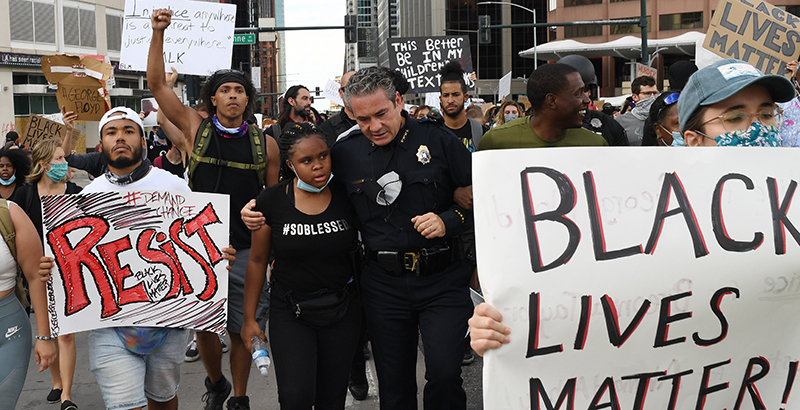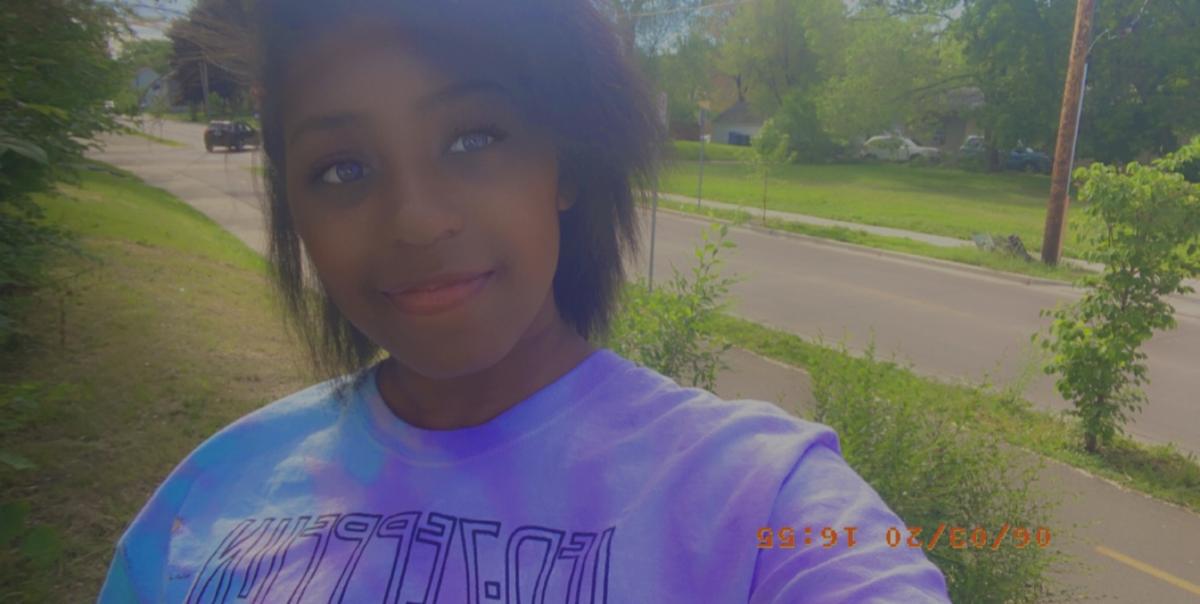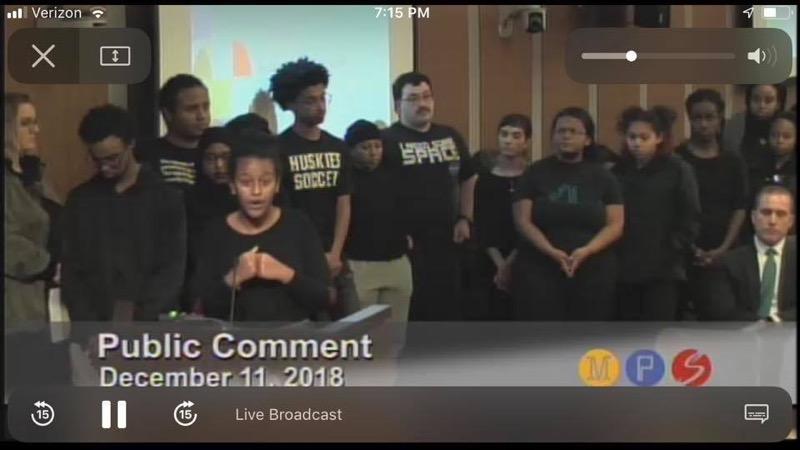For Years Before George Floyd’s Death, Schools Were Urged to Cut Ties With Police. Inside the Student Campaign That Convinced Minneapolis to Act — and Sparked a Nationwide Trend

Brianna Phillips’s life was already surreal when she answered a phone call that turned out to be from a reporter in Norway. A sophomore at Minneapolis’s Patrick Henry High School, she lives “over north” — local parlance for a swath of the city impacted dramatically by both COVID-19 and the protests that have swept the city since the death of George Floyd in police custody on Memorial Day.
When the phone rang, Phillips’s family was settling back into their house, which they had fled the weekend before, when fires set by looters got dangerously close. The Norwegian reporter wanted to talk about Phillips’s role in the Minneapolis Board of Education’s decision to end its relationship with the city police department.
A relatively newly minted activist, Phillips works with a group of students that for years has pushed Minneapolis Public Schools to end its contract with the department for school resource officers. A member of Our Turn, she had sent the group’s most recent petition to the district’s Board of Directors.
Floyd’s death, the students wrote, was too much. “He screamed ‘I can’t breathe’ while a Minneapolis police officer kneeled on his neck for several minutes,” the petition states. “We must call this what it is. This was a modern-day lynching. MPS should no longer be willing to be linked to the criminalization and killing of black and brown bodies.”
After a historic vote Tuesday night terminating the contract, school board chair Kim Ellison credited Minneapolis students for keeping the issue of police in schools at the top of the agenda and vowed to include them in deciding what happens next.
“Students have been telling us for years,” she said in an interview with The 74. “I’m sorry we’ve not listened to them.”
Overnight, the Minneapolis board’s vote has had a ripple effect, as districts throughout the country — some of them under pressure from students for years — are now talking about removing their own school resource officers.

Josh Pauly, the school board member who introduced the resolution ending the Minneapolis police contract, told The 74 that by late afternoon Wednesday, he had heard from education officials in dozens of communities who were trying to think through doing the same. Though he was reluctant to name districts, he said he had been contacted by officials in Minnesota, Wisconsin, Illinois, North Carolina, Colorado, Oregon, Washington, New York and California.
On Thursday, Portland, Oregon, Public Schools said it was discontinuing the use of police in its schools. In Rochester, New York, the city budget currently under consideration would put an end to placing police officers in schools, something students have been pushing for, according to the Democrat & Chronicle.
In Denver, Board of Education Vice President Jennifer Bacon and Secretary Tay Anderson announced a resolution Friday that calls for all police to be removed from the schools by year’s end. They said they would advocate to use the money freed up to bolster in-school mental health supports, something the city’s student activists had been demanding before this week’s protests swept the nation.
One of those student activists, Ashira Campbell, is a rising senior at DSST: Byers High School. Though her school doesn’t have a prominent police presence, she joined the effort to replace SROs throughout the city with student supports in part because a librarian wrongfully called police on her and her friends several years ago.
“I don’t think it’s necessary for police to be in schools,” she says. “We’re children, at the end of the day.”
On Monday, Campbell found herself marching near Denver Police Chief Paul Pazen. “The only thing I could think of was, ‘Chief, we can’t be doing this anymore,’” she recounts. “I can have this conversation with you, but we’re not done until I see it on paper, not until I see some real change.”
A photo of the chief locking arms with the 17-year-old graced the front page of the Denver Post.
Ashira Campbell, 17, of Denver speaks with Denver Police Chief Paul Pazen about wanting change as Pazen marches arm and arm with peaceful protesters during a protest over the death of George Floyd on June 1, 2020 in Denver, Colorado. @denverpost pic.twitter.com/HuOmMWHn7R
— RJ Sangosti (@RJSangosti) June 2, 2020
Judith Browne Dianis, executive director of the Advancement Project National Office, a nationwide civil rights organization, says youth organizations throughout the country — including the Philadelphia Student Union, Brighton Park Neighborhood Council of Chicago and Freedom Inc. in Madison, Wisconsin — have demanded for years that school boards end the police presence in their buildings.
“Minneapolis Public Schools District has had a long history of pushing black and brown students into the school-to-prison pipeline,” she said in a statement. “It is an important corrective step forward for the school board to recognize that MPD has shown that they cannot be trusted and should not be in schools. There have been too many examples across the country of police violence against students in our school hallways and criminalization of students of color.”
St. Paul Public Schools, which has a long and painful history of community division around the role of police in its buildings, is set to take up the issue in coming days.
‘The budget is a moral document’
In recent years, districts across the country have been under conflicting pressures. In response to mass shootings like the ones at Parkland and Santa Fe high schools in 2018, they have beefed up security — some districts going so far as to create their own police departments. At the same time, civil rights activists continue to sound the alarm about the role that police, frequently lacking training in dealing with children and de-escalating nonviolent behavior, play in racial disparities in school discipline. A 2018 New York Times investigation found that black students in Minnesota are suspended at eight times the rate of white ones. Nationally, there is a 3-to-1 disparity.
In 2014, Minneapolis Public Schools entered into a formal agreement with the U.S. Education Department’s Office for Civil Rights to, among other things, stop the schools’ practice of removing students from classrooms for nonviolent behavior perceived as disruptive or defiant. Police intervention in these instances was criticized at the time by, among others, student members of the local Black Liberation Project and the Young People’s Action Coalition.
In 2015, the police shooting of a black man named Jamar Clark sparked 18 days of protests in the city’s northside neighborhoods. A photo showing an officer aiming a gun at Jeremiah Ellison, now a city council member, went viral. Ellison is the son of Kim Ellison and Keith Ellison, who was a congressman at the time and is now the state attorney general.
Photo is agonizing for me to see. My son is PEACEFULLY protesting w/ hands up; officer is shouldering gun. Why? https://t.co/TTUBR0fxtS
— Keith Ellison (@keithellison) November 19, 2015
Keith Ellison’s top reason for leaving Congress and running for AG was a desire to have more direct power to enforce Minnesotans’ civil rights. He swiftly took control of the prosecution of the four officers involved in Floyd’s killing away from a county attorney with a long history of not charging police. Ellison arrested and jailed all four, who had been fired soon after the incident, and increased the charges against Derek Chauvin, the 19-year veteran who kneeled on Floyd’s neck, to second-degree murder.
In 2017, the board considered terminating the police contract but ultimately voted no. Kim Ellison says board members felt that having officers who wanted to be assigned to schools and received some specialized training was better than administrators taking their chances with whoever was on the beat when they were forced to call 911.
After that vote, activists decided to start the push for nonrenewal long before the contract was to expire in August 2020. “We wanted to get in early enough to get them to start thinking about having a serious alternative to having police in schools,” said Kenneth Eban, a former student activist who is now senior manager of organizing for Our Turn Twin Cities. Students stepped up their appearances at school board meetings, he says: “We came in force. We showed up in all black and delivered our petitions.”

Coincidentally, the day after Floyd’s death, the board had been slated to discuss next year’s budget. Says Kim Ellison said, acknowledging students’ line of reasoning: “The budget is a moral document. We give money to the police department, and their values do not align with ours.”
As for what happens next, Minnesota’s Intermediate District 287, a co-op of suburban districts outside the Twin Cities, might provide some insights. The district serves students with intense levels of need, including youth involved with the criminal justice system or exhibiting volatile behavior.
Almost four years ago, 287 began the process of ending its contracts with police departments in three communities where its schools are located. The decision was partly financial — the police wanted two officers in each building, driving up the cost significantly. But there were also racial concerns; the officers in schools were all white, while the student population is more than 50 percent youth of color.
“Most of our kids are coming to us with diagnosed or undiagnosed mental health problems,” says Superintendent Sandy Lewandowski. “We concluded that a police officer approach to mental health was not what we needed.”
Placing safety coaches — diverse by race, gender and sexual orientation — in schools all day, supporting students in a variety of capacities, reduced the need for police intervention to less than 1 percent of incidents in the 2017-18 school year.
https://www.youtube.com/watch?v=0RSc6D-TPG0&t=148s
‘What I’m hoping is we listen to the community, students included.’
In the fall, Glenda Young Shinnick will be a senior at Minneapolis’s North High School, where reaction to the contract’s termination was mixed. The school serves students who live in neighborhoods with some of the most fraught police-community relations, but it also has a beloved school resource officer who is a North graduate and coach of its storied football team.
She is among the students who pushed to remove the school resource officers, “even though it would suck to not have ours.” A member of the district’s CityWide Student Leadership Board, she knows that her peers in other schools have a different experience.
“Their [school resource officers] come from the suburbs and are not comfortable around black people,” she says. “Now, with all this going on, I feel like seeing how police have reacted to people being peaceful [while protesting], I don’t feel safe. I don’t feel like students in other schools are safe.”
This time, says board chair Ellison, the district must include youth in forging the path forward: “What I’m hoping is we listen to the community, students included, and think about how we make what they want work.”
Get stories like these delivered straight to your inbox. Sign up for The 74 Newsletter

;)
